Wetlands
Wetlands [болота; bolota]. Land areas with excessive moisture that provide a habitat for moisture-loving plants, the remains of which often accumulate to form peat. Wetlands may form along watercourses with impeded drainage, in and around shallow bodies of water with low shorelines, and in areas of humid climate (even away from bodies of water) where the soil is inadequately aerated, and decaying processes are impeded. Wetlands may be classified into three types according to the supply of water-borne minerals, the type of peat cover, and the nature of the vegetation: lowland (eutrophic), upland (oligotrophic), and transitional (mesotrophic).
Wetlands in Ukraine belong principally to the lowland and the transitional types. Upland wetlands make up no more than 10 percent of its wetlands by area alone. Ukrainian wetlands may also be subdivided according to vegetation into three types, sphagnum, grassy, and wooded. Sphagnum wetlands (which correspond to the upland wetlands) are found mostly in western Polisia and the Carpathian Mountains. Among the grassy wetlands the most widespread are sedge wetlands; they are followed closely by high grass wetlands consisting of reeds, cattails, and rushes. High grass wetlands are widespread in the floodplains of the forest-steppe and steppe zones. Wooded wetlands, including the alder, birch, and willow-pine subtypes, are found mainly in Polisia.
Wetlands occupy about 1 million ha, or 1.7 percent of the land surface of Ukraine. They claim the most significant share of the territory in the forest belt (5–30 percent of a given raion), much less in the Left-Bank Ukraine forest-steppe (2–5 percent), even less in the Right-Bank Ukraine forest-steppe (up to 2 percent), and the least in the steppe (up to 1 percent). The most extensive wetlands are found in Polisia, along both sides of the Prypiat River, especially in its western reaches (Volhynia oblast and Rivne oblast), where they occupy large expanses and extend along river valleys. Grassy wetlands known as hala occupy up to 90 percent of the wetlands in that region. Central Polisia has fewer wetlands, particularly along the Dnipro River. More wetlands are found in the Chernihiv Polisia, notably on the Dnipro River-Desna River Divide (the Zamhlai Marsh) and on the floodplains of little rivers. In Western Ukraine pockets of wetlands occur along rivers such as the Buh River, the Styr River, the Dnister River (the Sambir Marsh), and the Tysa River (the Chorne Boloto or Black Marsh). The Left-Bank Ukraine forest-steppe has wetlands mostly in the floodplains of rivers such as the Sula River, the Udai River, and the Khorol River. In the Right-Bank Ukraine forest-steppe isolated wetlands are encountered in only a few river valleys. In the steppe zone the typical wetlands are found in floodplains known as plavni. Those reach their largest expanses in the mouths of major rivers, notably the Danube River, the Dnipro River, and the Kuban River.
The economic exploitation of wetlands in their natural state for agriculture or forestry has offered limited returns. Hay harvested from grassy wetlands has generally been coarser than that from meadows, and wooded wetlands have yielded relatively low value in small trees. The harvesting of reeds, cattails, and berries has provided only marginal income to those engaged in cottage industry handicrafts or food processing. Only the extraction of peat for fuel has provided a major industrial benefit. Furthermore, wetlands hindered transport and were conducive to the breeding of locusts and mosquitoes. Accordingly, the drainage of wetlands in Ukraine was considered to be a wise economic policy (see Drainage of land).
The amount of drained agricultural land in Ukraine surpassed three million hectares in 1987. Some of the drained areas have been retained as hayfields; others have been plowed for the growing of crops, such as oats, buckwheat, cabbage, potatoes, and clover. As a consequence of the drainage the area of wetlands declined to approximately one million hectares in the 1980s.
The combined effect of drainage and the reduction in area of the wetlands has increased spring flooding and reduced the summer flow of the Prypiat River and other rivers that were formerly flanked by wetlands. Wetlands not only act like a sponge, regulating the water flow of rivers, but also serve as a buffer against shoreline and riverbank erosion. Furthermore, wetland vegetation (notably reeds and cattails) has a high capacity to act as a pollution filter (an important consideration when surface water is to be used for drinking). Finally, wetlands serve as refuges for wildlife, which is becoming impoverished as a result of the extinction of species. Because of their valuable ecological functions, wetlands are now being viewed as natural ecosystems that should be subject to conservation.
BIBLIOGRAPHY
Zerov, D. Bolota URSR: Roslynnist’ i stratyhrafiia (Kyiv 1938)
Bradis, Ie.; Bachuryna, H. Bolota URSR (Kyiv 1969)
Torfovo-bolotnyi fond URSR, ioho raionuvannia ta vykorystannia (Kyiv 1973)
Tipy bolot SSSR i printsipy ikh klassifikatsii (Leningrad 1974)
Ihor Stebelsky
[This article originally appeared in the Encyclopedia of Ukraine, vol. 5 (1993).]
